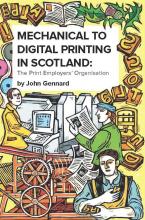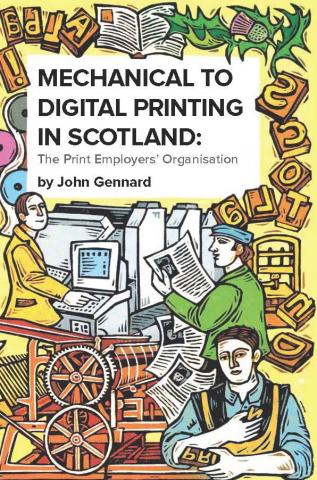
 A hundred years ago, twenty three delegates from all over Scotland met in the North British Hotel, Edinburgh, and founded the Scottish Alliance of Masters in Printing and Allied Trades, later known as the Scottish Master Printers Society and the Scottish Print Employers Federation. Now know as Graphic Enterprise Scotland, this book marks the organisation’s centenary by tracing its evolution during a century of technological change in one of Scotland’s most significant industriues.
A hundred years ago, twenty three delegates from all over Scotland met in the North British Hotel, Edinburgh, and founded the Scottish Alliance of Masters in Printing and Allied Trades, later known as the Scottish Master Printers Society and the Scottish Print Employers Federation. Now know as Graphic Enterprise Scotland, this book marks the organisation’s centenary by tracing its evolution during a century of technological change in one of Scotland’s most significant industriues.
This book is a culmination of six years work by John Gennard, produced through painstaking analysis of a massive volume of documentation accumulated since 1910, and by face-to-face interviews with significant individuals associated with the organisation.
The story told is a fascinating one, which wends its way through history from the installation of the first printing press in Edinburgh in 1507 to the effects and implications of modern digital printing of today.
Although our organisation was founded only in 1910, John explains in some detail the development of printing in Scotland to that date and the very significant technological changes brought about by the introduction of mechanical typesetting at the end of the nineteenth and early twentieth centuries. He demonstrates clearly how these changes radically affected the economics of printing and the effects on people in print and the development of organised labour.
Indeed, the original reasons for the formation of the Scottish Alliance of Masters in Printing and Kindred Trades on 8th November 1910 are identified as the introduction of mechanical composition through the Linotype and Monotype machines, the growth of the trade union membership and power, the creation of a national federation of print unions and the need to deal with the issue of product market competition based on price-cutting between Scottish Master Printers.
The author takes you carefully through the name changes to the Scottish Alliance of Master Printers 1953, Society of Master Printers of Scotland 1960, the Scottish Print Employers Federation 1990 and to Graphic Enterprise Scotland 2008. At each change he indicates the socio-economic dynamics coming into play and how they are all associated with technological change, organised labour, collective agreements, and government policy and legislation.
One of the significant themes throughout the history is that, despite the name changes, the role of the organisation has changed little. Core services of negotiation of collective agreements with the trade unions, the training of apprentices and political lobbying still remain with us today. The author also outlines technological changes such as direct to plate, direct to press, digital printing and the progressive amalgamation of the trade unions into Unite the union, as a modern day version of the ‘raison d’être’ of the organisation.
A recurring feature of the story is our relationship to other print employers’ organisations, elsewhere in the UK. Scotland had been a founder member of the BFMP but in 1910 formed its own organisation. It progressively developed its autonomy in finance, conditions of membership, its own collective agreements and over the years pulled out of areas of influence at the BFMP, such as representation on the governing council and major sub-committees. It is particularly apt since John explains the ups and downs of a fractious relationship with the BFMP and its successor organisation, not finally settled until 1984.
Membership numbers have also changed in line with the economic changes encountered in our history. Membership was at its peak in the 1950s and 1960s, but since then it has been in decline through liquidations, takeovers and amalgamations. However, as John illustrates, the organisation has always managed to attract new members and he points out that one of the objectives of GES today is to recruit new full and associate members, together with developing new services in line with members’ business requirements. Success to date has been limited and the industry still exhibits the commercial pressures of poor margins, falling demand, a strong pound, overcapacity and downward pressure on pricing. John also adds the new challenges of e-procurement and new media.
John skilfully portrays our history over the past 100 years, chronicling our passage through the growth of printing companies in Scotland, the development of craft unions, the response to organised labour and the impact of technical change on individuals, organisations and labour relations. This work will be of interest to any social historian but, in particular, to anyone with any connection to the printing industry.
The book is a testimony to the scholarship of the author and to the people in the organisation and industry over the past century. We have survived by reacting to changes in printing and the commercial factors within Scotland and the UK.
